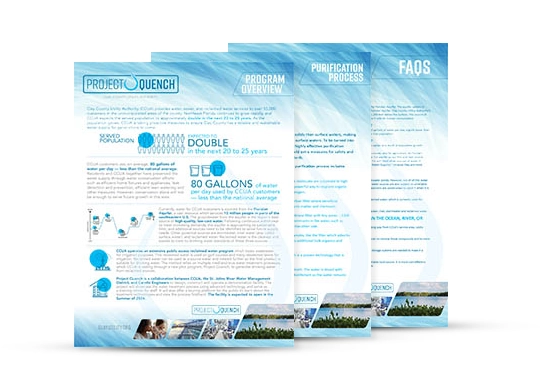Clay County Utility Authority is proud to introduce project quench
Clay County Utility Authority (CCUA) is actively planning to create and ensure a reliable and affordable water supply to serve population growth. We are operating an extensive public access reclaimed water program which treats wastewater for irrigation purposes. Reclaimed water can be used as a source water and treated further so the final product is suitable for drinking water. The method relies on multiple tried-and-true water treatment processes, which CCUA is testing through a new pilot program, Project Quench, to generate drinking water from reclaimed sources.
Project Quench is a collaboration between CCUA, the St. Johns River Water Management District, and Carollo Engineers to design, construct and operate a demonstration facility. This facility showcases the water treatment process using advanced technology and serves as a training center for staff. It also offers a touring platform for the public to learn about the treatment technologies and view the process firsthand.
Our Facility
Frequently Asked Questions
Drinking water supplies in North Florida and much of the state rely on groundwater from the Floridan Aquifer. The aquifer system in Florida consists of the shallow Surficial Aquifer, the Intermediate Aquifer, and the deeper Floridan Aquifer. Clay County Utility Authority’s (CCUA) water treatment plants withdraw groundwater from Floridan Aquifer wells 800 to 1,200 feet below the surface. This source of water is of excellent quality. CCUA removes sulfur from the water and chlorinates it to make it safe for human consumption.
Potable reuse is the process of effectively treating reclaimed water to the highest drinking water standard by utilizing multiple treatment barriers. It is the next step in CCUA’s proactive approach to evaluating alternative supplies to serve our community’s growth needs.
Potable reuse combines tried and tested treatment technologies with the latest water quality monitoring and testing advancements. Treatment techniques like filtration, adsorption, advanced oxidation, and advanced disinfection are employed for chemical and pathogen removal.
Upon complete treatment, the resulting water exceeds regulatory requirements set forth by the U.S. Environmental Protection Agency and the Florida Department of Environmental Protection.
Several States and utilities are either exploring or implemeting potable reuse to meet water shortages. The City of El Paso is constructing a 10 million gallons per day advanced purification facility, while the City of San Diego is constructing a 30 million gallons per day facility. Orange County, California has been treating over 100 million gallons per day for over a decade. Closer to home, JEA is building a demonstration and research center for pure water injection into the aquifer, augmenting their drinking water supply source.
Developing a safe, sustainable, cost-effective water supply program takes careful planning and time to study. CCUA is investigating potable reuse today to see if it’s the right solution as a future water supply source.
A variety of reputable resources have extensively studied potable reuse. You can find additional information at One Water Florida, WateReuse National, and EPA Reuse Action Plan.
Upcoming Info Sessions
Come find out more about Project Quench!
jan 25
Test Event
Lorem ipsum dolor sit amet, consectetur adipiscing elit, sed do eiusmod tempor incididunt ut labore et dolore magna aliqua. Ut enim ad minim veniam, quis nostrud exercitation ullamco laboris nisi ut aliquip ex ea commodo consequat.
jan 26
Test Event 2
Lorem ipsum dolor sit amet, consectetur adipiscing elit, sed do eiusmod tempor incididunt ut labore et dolore magna aliqua. Ut enim ad minim veniam, quis nostrud exercitation ullamco laboris nisi ut aliquip ex ea commodo consequat.

Learn more about the project and download our informational material! View our process one-sheet, program overview or faqs.
Download